Lubuntu 10.04 released
 For those who don't know, Lubuntu is a Linux distribution based on Ubuntu and LXDE .
For those who don't know, Lubuntu is a Linux distribution based on Ubuntu and LXDE .Its main feature is the low requirements for computer resources and at the same time fast operation of the graphical interface. Lubuntu is focused primarily on weak low-end computers (netbooks, old desktops, old laptops).
According to the developers, Lubuntu works pretty well on computers with a Pentium-II / Celeron-level CPU and 128MB RAM and less (even works on 64 MB).
Lubuntu can also be useful for those who want to install a Ubuntu-like Linux distribution, but don’t want to devote a lot of resources to a voracious DE like Gnome or KDE.
Download links (image size 520 MB):
• Torrent (preferred option)
• Direct link (less preferred option)
• Magnet: magnet:? Xt = urn: btih: JFCJGRRORFOG3TDGWWE5Z4H5RX4BMGGU
MD5: 386a227968cbabc89e1a23b95035160e lubuntu-04.04.iso
Further the review of this distribution kit and screenshots.
Desktop environment
 Lubuntu uses LXDE as the Desktop Environment (hence the name Lubuntu = LXDE + Ubuntu).
Lubuntu uses LXDE as the Desktop Environment (hence the name Lubuntu = LXDE + Ubuntu).LXDE (Lightweight X11 Desktop Environmen) is a very light and fast DE, even smarter than Xfce, which is used in Xubuntu.
LXDE is an open source project (GPL / LGPL) written in C and using the GTK + library.
Due to the lightness of LXDE, the graphical environment works pretty quickly even on weak hardware.
')
Project history
The LXDE project began in 2006 with the development of the lightweight graphical file manager PCManFM, which was developed by a Taiwanese programmer Hong Jen Yee (with the nickname PCMan). Later, other developers joined the project, and other modules for the desktop environment were written, which together with the Openbox window manager merged into the LXDE desktop environment.LXDE, Lubuntu and Canonical
In February 2009, Mark Shuttleworth invited the LXDE project to the Ubuntu community as an independent project, the task of which is to create a distribution kit based on Ubuntu and LXDE with a fast, lightweight, but fully functional interface. The project on Launchpad received the name Lubuntu and an ubuntu-like logo. The project page is also on wiki.ubuntu.com.But in spite of all this, Lubuntu is still not an official Canonical distribution kit and is not part of the Ubuntu family of distributions (which now include Ubuntu, Kubuntu, Xubuntu, Edubuntu). Those. Canonical Ltd. does not develop, support and distribute the Lubuntu distribution. The Lubuntu project is independently managed by the LXDE developers.
And among the main objectives of the project Lubuntu, designated by the authors on the wiki-page , it is worth winning Canonical recognition and officially entering the family of Ubuntu distributions. Since this has not happened yet, it seems that Canonical believes that Lubuntu is not yet ready for this.
In August 2009, the first public LiveCD was released from Lubuntu. Since then, the Lubuntu team has periodically released alpha / beta builds (usually a couple of days behind the corresponding Ubuntu builds). And finally, the time has come for the final Lubuntu 10.04 build.
Short FAQ
Q: Is there a build of an ISO image of Lubuntu for the x86-64 architecture?
A: Not today. Beta builds are only built for x86 (i686).
Q: What is the latest version of Lubuntu?
A: At the time of this writing, the last one is Lubuntu 10.04 final “stable beta” (dated April 30, 2010).
Q: If it's beta, will there be a release of Lubuntu 10.04?
A: No. In essence, “stable beta” is the release of version 10.04, i.e. final build of Lubuntu 10.04. It's just that the authors made the decision not to release releases until Lubuntu officially accepted Canonical into the family of Ubuntu distributions. Therefore, while the versions of Lubuntu, based on the final releases of Ubuntu, they are not called releases, but stable beta.
Q: Does Lubuntu 10.04 distribution have LTS (Long Term Support) status?
A: No. Long-term support for Canonical applies only to official Canonical distributions, to which Lubuntu does not yet apply.
What is included in the distribution of Lubuntu?
First of all, it is LXDE , which consists of the following components:
• Window manager (window manager): Openbox
• Login Manager: LXDM
• Window configurator: ObConf v2.0.3
• Session Manager: LXSession
• Customize themes and appearance: LXAppearance
• Desktop Panels: LXPanel v0.5.5
• Task Manager: xfce4-taskmanager v0.4.1
• Quick Start Application Interface (Netbook Interface): LXLauncher
• File Manager: PCManFM v0.9.5
• Image Viewer : GPicView v0.2.1
• Terminal emulator: LXTerminal v0.1.7
• Text editor: Leafpad v0.8.17
What other applications are installed with Lubuntu 10.04 by default:
Graphics:
• Graphic editor: mtPaint v3.31
• Scanning utility: Simple Scan v1.0.2
The Internet:
• Web browser: Chromium v5.0.342.9 (43360)
• Email client: Sylpheed v3.0.2
• Messenger: Pidgin v2.6.6
• Bittorrent client: Transmission v1.92 (10363)
• IRC client: XChat v2.8.6
• SMB browser for Windows networking: pyNeighborhood v0.4
Office applications:
• Office word processor: AbiWord v2.8.2
• Spreadsheet Editor: Gnumeric Spreadsheet v1.10.1
• Organizer (calendar / tasks / contacts / notes): Osmo v0.2.8
• PDF viewer: ePDFView v0.1.7
Media:
• Audio Player: Aqualung R-1114
• Video player: GNOME-mplayer v0.9.9.2
• Utility for webcam (video recording, photo): Cheese v2.30.0
• Burn CD / DVD-discs: Xfburn v0.4.3
Other:
• Disk utility: Gnome-disk-utility v2.30.1
• Archiver: Xarchiver v0.5.2svn-r29673
• Calculator: Galculator v1.3.4
• Clipboard manager: Parcellite v0.9.2
That's almost all. Pretty minimalist, but enough for basic needs.
Of course, it’s not necessary to be content with just what is put out of the box, using the Synaptic package manager or using the apt-get or aptitude console utilities to install the packages you need (i.e., everything as usual).
Screenshots
Well, now the promised screenshots (miniatures are links, links are full-size images).
The boot process (from the LiveCD) and the login screen (on an already installed Lubuntu):

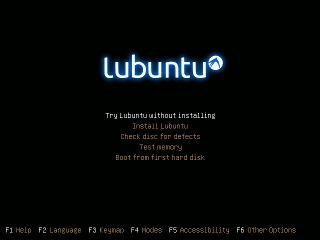
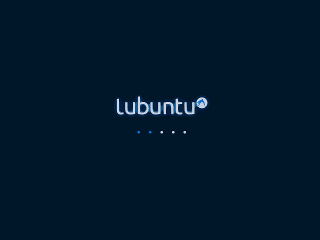
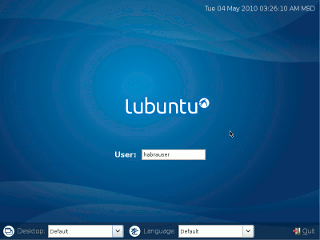
This is what Lubuntu looks like with the Clearlooks default theme:
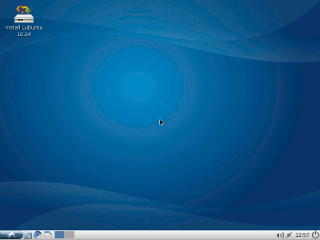

There are two virtual desktops by default, but if necessary it is easy to change through the Openbox Configuration Manager.
And of course Chromium with Habr:

And this is the main menu of LXPanel (in appearance and structure it strongly resembles the classic Start menu in Windows):
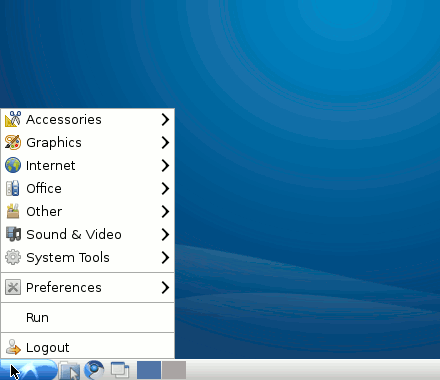
(made in the form of an animated GIF to show all the submenus)
Logout window:
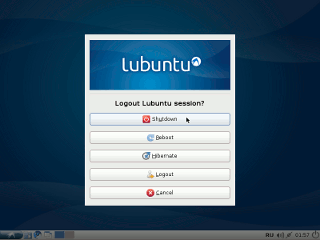
A few words about the "netbook interface"
As you can see in the screenshot above, in the logon window, in addition to the login / password input field, at the bottom of the screen there are two menus in the form of drop-down lists: Desktop and Language.
There is nothing interesting in the Language menu, there is a choice of language for a logon window only from variants of English and Chinese (haha, even here Chinese roots of Lubuntu developers are guessed). But in the Desktop menu there is something interesting, there is a list of several options for downloading the graphical environment:
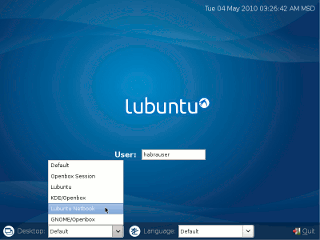
The Default and Lubuntu items are loaded after entering the normal view of Lubuntu, which is shown in the screenshots above. The Openbox Session item launches a minimalistic and low-performing graphical user interface with virtually a bare window manager, without LXDE. KDE / Openbox and GNOME / Openbox do not work (just because I did not install KDE or Gnome).
But on the point of Lubuntu Netbook I’ll dwell a little more.
When you select this item, LXLauncher is launched at login. This is a graphical interface that takes up the entire desktop, with tabs at the top. The tabs are large application icons for quick access to programs and system settings. Here's what it looks like:

(via animated gif link with demonstration of all tabs LXLauncher)
The interface is focused on small screens of netbooks, where it is inconvenient to work with a small main menu. The large tab icons right on the desktop should simplify this task.
In this case, the panel and the main menu are still present at the bottom of the screen, so if you want, you can use them.
My general impressions and conclusions
The ascetic, angular interface didn’t embarrass me much, though it’s simple, it’s quite acceptable, at least for weak computers. I am not at all a supporter of any heavy whistles-fakes with highlights and rainbow colors in graphical interfaces, so I can quite reconcile with the look of this interface (especially since I was morally ready for this). Although I suppose that the appearance of this desktop, especially its panels and fonts, can upset visual aesthetes and other connoisseurs of the beautiful.
But what I really didn’t like about Lubuntu is the lack of functionality and customization. The functionality is mostly solved by installing familiar applications, but with the customizability of the environment itself I don’t know what to do. Those. a bunch of annoying little things that cause inconvenience, and it is not clear how to configure them. For example, I did not find how to reassign keyboard layout keys (input language) of the keyboard through a graphical interface.
LXDE left me with the impression of some kind of incompleteness, lack of something or something. Those. when I worked with the interface, I did not leave the thought that something was missing and something was not configured. Sometimes it is even difficult to articulate what does not like, but something is wrong. Although this may be purely my subjective discontent with the habit, I do not know ...
After working with him for several days, I decided that I did not need Lubuntu, at least in its current state.
I sincerely wish the success of Asian developers in the further development of their product. Sometime later (in a year), maybe I will look at Lubuntu again. In the meantime, thanks, no.
Total, after three days of inspection and use of Lubuntu 10.04, I sighed, and blew the system. Especially since I set it exclusively for research purposes in the hope that I would like it and be very impressed.
In general, I do not know about you, but Canonical and I are not yet ready to make Lubuntu our distribution;)
Conclusion
I do not want to impose my opinion on Lubuntu on you and I do not want to discourage you from installing it. On the contrary, it would be very interesting for me that you also put it (or try it with the LiveCD) and share your impressions about working with it. It will be especially interesting to hear about the practice of using it on low-powered netbooks and ancient desktops (I did not have the corresponding low-power hardware). I wonder if he really is as good and fast as they say about him.
By the way, LXDE is not necessary to install along with Lubuntu, it can be screwed to other Linux distributions (Ubuntu, Debian, Mandriva, Fedora, openSUSE, etc.).
And if you need a Ubuntu-like distribution with LXDE, which already has a wider set of programs out of the box, I would recommend waiting for the release of the Linux Mint LXDE build based on the Lucid Lynx release. In Linux Mint (or in its Russian adaptation ) it is usually more and more finished and configured from the point of view of an ordinary user who wants to install the system and use it at once with all the comforts.
That's all for now.
Thanks for attention. Waiting for your feedback and comments.
Source: https://habr.com/ru/post/92697/
All Articles